Input interpretation

styrene
Chemical names and formulas
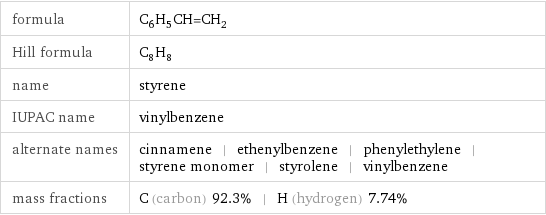
formula | C_6H_5CH=CH_2 Hill formula | C_8H_8 name | styrene IUPAC name | vinylbenzene alternate names | cinnamene | ethenylbenzene | phenylethylene | styrene monomer | styrolene | vinylbenzene mass fractions | C (carbon) 92.3% | H (hydrogen) 7.74%
Lewis structure
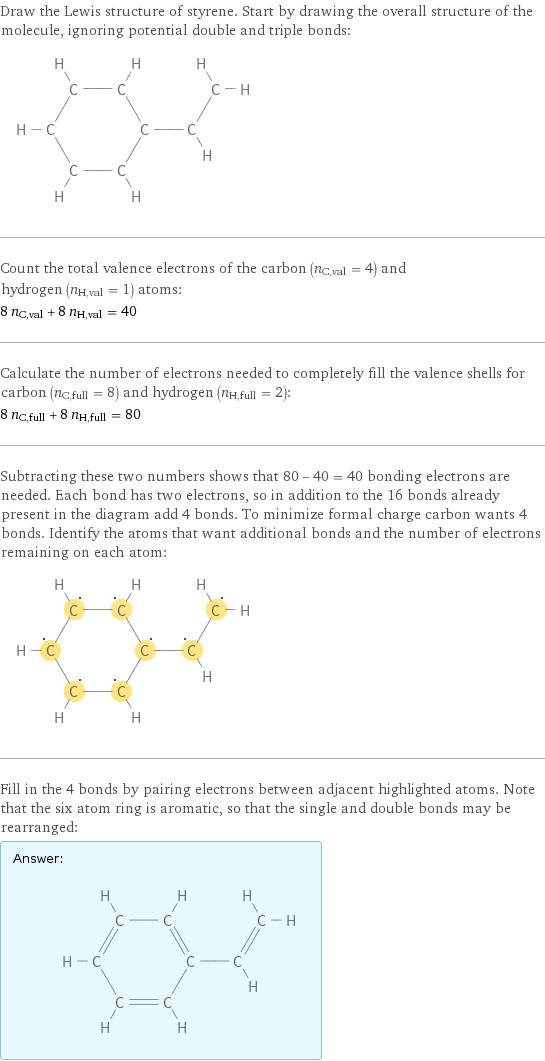
Draw the Lewis structure of styrene. Start by drawing the overall structure of the molecule, ignoring potential double and triple bonds: Count the total valence electrons of the carbon (n_C, val = 4) and hydrogen (n_H, val = 1) atoms: 8 n_C, val + 8 n_H, val = 40 Calculate the number of electrons needed to completely fill the valence shells for carbon (n_C, full = 8) and hydrogen (n_H, full = 2): 8 n_C, full + 8 n_H, full = 80 Subtracting these two numbers shows that 80 - 40 = 40 bonding electrons are needed. Each bond has two electrons, so in addition to the 16 bonds already present in the diagram add 4 bonds. To minimize formal charge carbon wants 4 bonds. Identify the atoms that want additional bonds and the number of electrons remaining on each atom: Fill in the 4 bonds by pairing electrons between adjacent highlighted atoms. Note that the six atom ring is aromatic, so that the single and double bonds may be rearranged: Answer: | |
3D structure
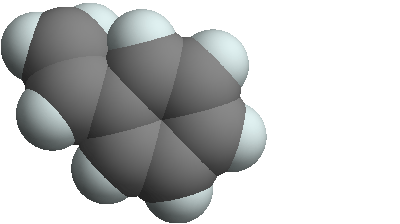
3D structure
Basic properties
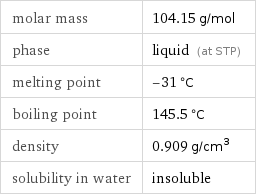
molar mass | 104.15 g/mol phase | liquid (at STP) melting point | -31 °C boiling point | 145.5 °C density | 0.909 g/cm^3 solubility in water | insoluble
Units

Liquid properties (at STP)
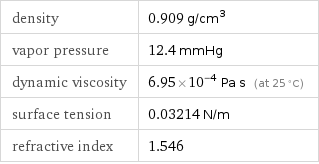
density | 0.909 g/cm^3 vapor pressure | 12.4 mmHg dynamic viscosity | 6.95×10^-4 Pa s (at 25 °C) surface tension | 0.03214 N/m refractive index | 1.546
Units

Thermodynamic properties
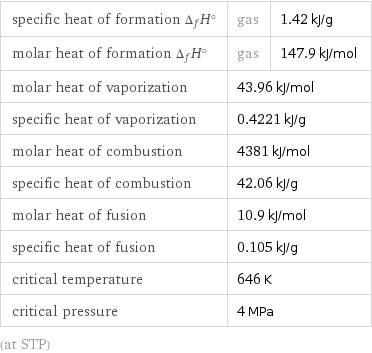
specific heat of formation Δ_fH° | gas | 1.42 kJ/g molar heat of formation Δ_fH° | gas | 147.9 kJ/mol molar heat of vaporization | 43.96 kJ/mol | specific heat of vaporization | 0.4221 kJ/g | molar heat of combustion | 4381 kJ/mol | specific heat of combustion | 42.06 kJ/g | molar heat of fusion | 10.9 kJ/mol | specific heat of fusion | 0.105 kJ/g | critical temperature | 646 K | critical pressure | 4 MPa | (at STP)
Chemical identifiers

CAS number | 100-42-5 Beilstein number | 1071236 PubChem CID number | 7501 SMILES identifier | C=CC1=CC=CC=C1 InChI identifier | InChI=1/C8H8/c1-2-8-6-4-3-5-7-8/h2-7H, 1H2 RTECS number | WL3675000 MDL number | MFCD00008612
NFPA label

NFPA label
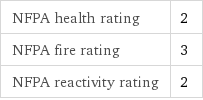
NFPA health rating | 2 NFPA fire rating | 3 NFPA reactivity rating | 2
Safety properties
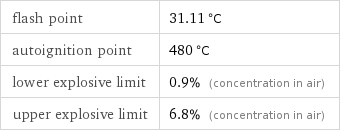
flash point | 31.11 °C autoignition point | 480 °C lower explosive limit | 0.9% (concentration in air) upper explosive limit | 6.8% (concentration in air)

DOT hazard class | 3 DOT numbers | 2055
Toxicity properties

lethal dosage | 5000 mg/kg (oral dose for rats) short-term exposure limit | 1050 mg/m^3 threshold limit value | 20 ppmv

probable lethal dose for man | 600 mL (milliliters) long-term exposure limit | 420 mg/m^3 (over 8 hours) RTECS classes | tumorigen | mutagen | reproductive effector | human data | primary irritant